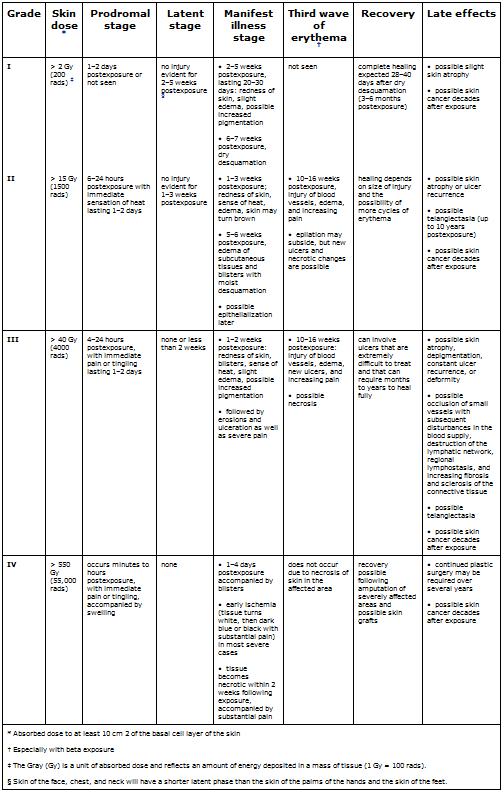Radiation injury: Difference between revisions
No edit summary |
No edit summary |
||
| Line 29: | Line 29: | ||
Recovery (months to years) | Recovery (months to years) | ||
[[CRI Table 1.jpg|800px|thumb]] | [[Image:CRI Table 1.jpg|800px|thumb]] | ||
Revision as of 02:02, 15 January 2009
Injury to the skin and underlying tissues from acute exposure to a large external dose of radiation is referred to as cutaneous radiation injury (CRI). Acute radiation syndrome (ARS) 1 will usually be accompanied by some skin damage; however, CRI can occur without symptoms of ARS. This is especially true with acute exposures to beta radiation or low-energy x-rays, because beta radiation and low-energy x-rays are less penetrating and less likely to damage internal organs than gamma radiation is. CRI can occur with radiation doses as low as 2 Gray (Gy) or 200 rads 2 and the severity of CRI symptoms will increase with increasing doses. Most cases of CRI have occurred when people inadvertently came in contact with unsecured radiation sources from food irradiators, radiotherapy equipment, or well depth gauges. In addition, cases of CRI have occurred in people who were overexposed to x-radiation from fluoroscopy units.
Early signs and symptoms of CRI are itching, tingling, or a transient erythema or edema without a history of exposure to heat or caustic chemicals. Exposure to radiation can damage the basal cell layer of the skin and result in inflammation, erythema, and dry or moist desquamation. In addition, radiation damage to hair follicles can cause epilation. Transient and inconsistent erythema (associated with itching) can occur within a few hours of exposure and be followed by a latent, symptom-free phase lasting from a few days to several weeks. After the latent phase, intense reddening, blistering, and ulceration of the irradiated site are visible. Depending on the radiation dose, a third and even fourth wave of erythema are possible over the ensuing months or possibly years.
In most cases, healing occurs by regenerative means; however, large radiation doses to the skin can cause permanent hair loss, damaged sebaceous and sweat glands, atrophy, fibrosis, decreased or increased skin pigmentation, and ulceration or necrosis of the exposed tissue.
With CRI, it is important to keep the following things in mind:
- The visible skin effects depend on the magnitude of the dose as well as the depth of penetration of the radiation.
- Unlike the skin lesions caused by chemical or thermal damage, the lesions caused by radiation exposures do not appear for hours to days following exposure, and burns and other skin effects tend to appear in cycles.
- The key treatment issues with CRI are infection and pain management.
Stages and Grades of CRI
CRI will progress over time in stages and can be categorized by grade, with characteristics of the stages varying by grade of injury, as shown in Table 1. Appendix A gives a detailed description of the various skin responses to radiation, and Appendix B provides color photographs of examples of some of these responses.
Prodromal stage (within hours of exposure)—This stage is characterized by early erythema (first wave of erythema), heat sensations, and itching that define the exposure area. The duration of this stage is from 1 to 2 days.
Latent stage (1–2 days postexposure)—No injury is evident. Depending on the body part, the larger the dose, the shorter this period will last. The skin of the face, chest, and neck will have a shorter latent stage than will the skin of the palms of the hands or the soles of the feet.
Manifest illness stage (days to weeks postexposure)—The basal layer is repopulated through proliferation of surviving clonogenic cells. This stage begins with main erythema (second wave), a sense of heat, and slight edema, which are often accompanied by increased pigmentation. The symptoms that follow vary from dry desquamation or ulceration to necrosis, depending on the severity of the CRI (see Table 1).
Third wave of erythema (10–16 weeks postexposure, especially after beta exposure)—The exposed person experiences late erythema, injury to blood vessels, edema, and increasing pain. A distinct bluish color of the skin can be observed. Epilation may subside, but new ulcers, dermal necrosis, and dermal atrophy (and thinning of the dermis layer) are possible.
Late effects (months to years postexposure; threshold dose ~10 Gy or 1000 rads)—Symptoms can vary from slight dermal atrophy (or thinning of dermis layer) to constant ulcer recurrence, dermal necrosis, and deformity. Possible effects include occlusion of small blood vessels with subsequent disturbances in the blood supply (telangiectasia); destruction of the lymphatic network; regional lymphostasis; and increasing invasive fibrosis, keratosis, vasculitis, and subcutaneous sclerosis of the connective tissue. Pigmentary changes and pain are often present. Skin cancer is possible in subsequent years.
Recovery (months to years)
